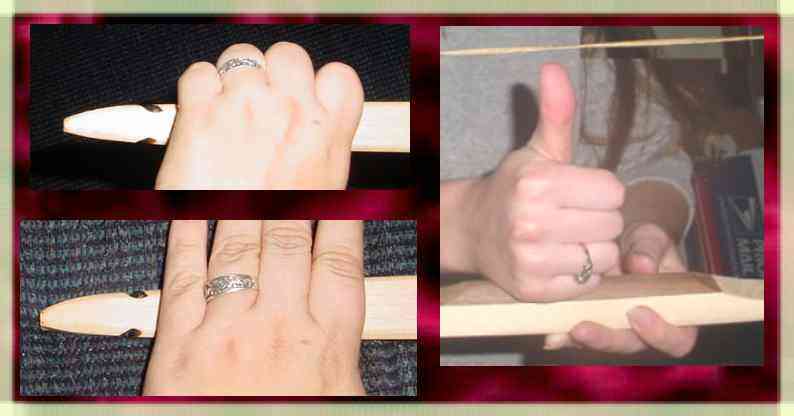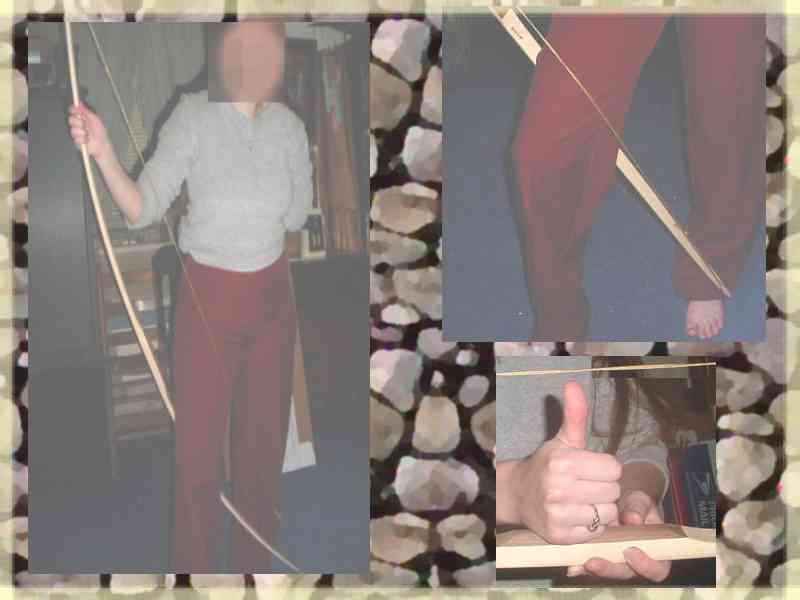
Care Instructions for Kee’s Longbows
All wood bows do not tolerate a "dry fire" or broken string the way modern bows do. They can be permanently damaged by being severely or repeatedly over drawn. The wood fibers will become stressed beyond the range of the original tiller & never return.**Wood bows should only be drawn to the corner of the mouth, unlike conventional bows, they should not be draw to the ear. **
°Setting The Brace Height: Brace height is the distance between the string and the handle on the bow when strung. By twisting the string in the direction of the twist the string will shorten, and vise-versa when you un-twist the string will get longer. The proper height is set for the person shooting by closing his/her fist and sticking up his/her thumb straight up. The fist with the thumb up should pass between the bow and the string with no more than 1/32" clearance. (there can be up to a max. of 6"- 6 1/2" of clearance) Strings are sinew and will stretch a little when new and may need to be adjusted several times before proper brace is achieved. The bow has a draw length of 28". 28" or 29" arrows can be used, if you shoot arrows longer than 29" place a black ring around the arrow at 29" from the notch on the arrow so that you do not over draw your bow and damage it or break it. Arrows should be bought according to the draw length you use. The spine weight of the arrows should be matched to the bow as well. – Max Brace height on a Childs bow is 4 ˝”, & arrows should not exceed the draw length of the bow

When stringing your wood bow use the following methods.
1.) The
step thru method (also known as the traditional method)
2.) The lazy mans way (the knee on the handle)
3.) Use a bow stringer – an even force stringer
works best
Never step or stand on the tip or shove the tip into the ground/floor when stringing. Doing so could damage your bow or even break your bow. If you do not know how to do any of the above methods please see your local archery shop and have them show you how to string a bow with one of the above methods. The step through method is the safest way to string your bow if done properly, both for you and your bow.

°Selecting the right spine weight: The spine weight of your arrow should be 5 - 10# lighter than your bow** The reason for matching the spine weight of your arrows to your bow, is so that you get the max. performance out of the bow. Arrows that are to heavy (spine weight as heavy or heavier than your bow) will end up mostly in the ground. Arrows that are too light (spine weight Lighter than recommended for your bow) will not fly straight, they will wobble too much in flight **On Recurves (true recurves) the spine weight should be 5 - 10# heavier.
°String Information and Care:
1. The following information pertains to artificial sinew or flemish strings. String nocks and string servings can be safely added to strings without damaging the string, and can be purchased at most archery supply stores.
2. String Care: Use bees wax when the string becomes frayed to smooth it back out. Waxing your string with bees wax regularly or before you put it up for a season (if you use it only to hunt), will increase the life of your string. Also store or keep your string away from household pets, as your pet may "eat" your string.
3. Should you need to replace the string on your wood bow, buy a string that is 4"(inches) shorter than your bow. The string should not be any shorter than this. If the string is a little long it can be twisted down. However if the string is to short you could break your bow. (ex: if your bow is 72" (inches) long/tall from tip to tip you would buy a 68" (inch) string for it.)
4. B-50 can be used as an alternative to the artificial sinew & natural strings.
However, Fast flight should NEVER be used on a wood bow.
°Basic Care Information for a wood bow:
1.Unless you seal your wood bow with a polyurethane or something similar. You will need to Oil your wood bow every 4-6 months, to prevent it from drying out. The following oils can be used. Other oils can also be used these are just the more popular ones. (Remember this does not apply to sealed or painted bows)
a.) Tung Oil --- considered by bowyers to be the best to use
b.) Linseed Oil --- this oil takes forever to dry, so
wipe excess off
c.) Lemon Oil --- Many people use this just because
its handy
2.Your wood bow should be stored flat. Under a bed is usually the best place to store it. That way its out of the way and not being kicked or stepped on. Or hang it from the string nocks.
3. NEVER store a wood bow strung. It can cause it to take a set or follow the string in a pronounced way. As well as cause it to loose strength or power.
4. It is sometimes wise to store the bow and string separately. This will prevent someone from attempting to mis-string & attempt to draw and ultimately break your bow. Also as mentioned earlier, this would prevent your pet(s) from eating your string. So for households with pets or children we strongly urge you to store the string separately from your bow.
**Oil may remove the paint on painted bows, paint seals the bow and prevents moisture from getting in, this is why there is no need to oil the painted or stained bows.
°Shooting a wood bow or a wood longbow: When shooting traditionally; they shot off the hand (knuckles). If you are shooting this way or intend to just remember that if your right handed the arrow will rest on the left hand side of the bow (visa versa if your left) and make sure the fletching (feathers) on your arrows are good. Also it may be a good idea to wear a leather glove when shooting this way; if possible. A shelf can be safely added to the side of a traditional style bow (one with no built in shelf) by wrapping a wedge of wood, a shaped piece of bone, or a stiff wedge of belt leather to the appropriate side with jute, leather or just about any pliable material. (please contact us for full instructions)
Above is an example of an arrow rest being added with a rolled piece of leather for the rest and a matching piece of leather for the wrap (grip) and how to "tie" it off.
°Additional tips for shooting a longbow:
1. Arrows should be inspected for crakes or abrasions before each use and after you hit something solid with one such as a Tree, brick wall, rock, etc. **Do Not use damaged arrows!! **
2. Arrows should be wrapped at the bottom of the feathers with thread, sinew, or tape to prevent them from sticking into the hand. (when there is not a shelf / arrow rest on the bow being used).
3. Archers should stand at a 45 degree angle to there target and then hold the bow, with the arm bent slightly, towards the target. Then let the arm adjust itself for range.
4. Straw bails make good targets. Be sure nothing / no one is behind the targets. When shooting, make sure all bystanders are behind the shooter before starting. Never walk around with an arrow nocked on the bow!!
Warranty Information for Your New Longbow
Your bow has a 30 day Limited Replacement Warranty: for workmanship or internal flaw that did not show in testing. Unless otherwise stated as different at the time of sale (ex: Sold AS IS.)
Warranty is VOID if:
(a.)
The bow has been altered by cutting, carving, drilling holes into it in any way,
this includes shortening and carving an arrow rest.
(b.) Or that the tips have broken
off due to improper stringing
(c.)
We will NOT replace adult or youth bows broken by overdraw (drawing further than
marked ON bow, as each bow is marked to its max. draw).
(d.) If the bow was strung
backwards and/ or pulled while stung backwards.
(e.) If the bow leaves the
U.S.A.
Kee’s Traditions Additional Information about your bow
P.O. Box 1884 Bow
Weight: #
(lbs) @ ” (inches of draw)
Leander, TX 78646 Wood
Type:
(512)-573-5761
Recommended Spine weight for arrows:
#
LadyKee@KeesTraditions.com Date of Purchase:
www.KeesTraditions.com